MARIANI’S
Virtual Gourmet
February
15, 2015
NEWSLETTER
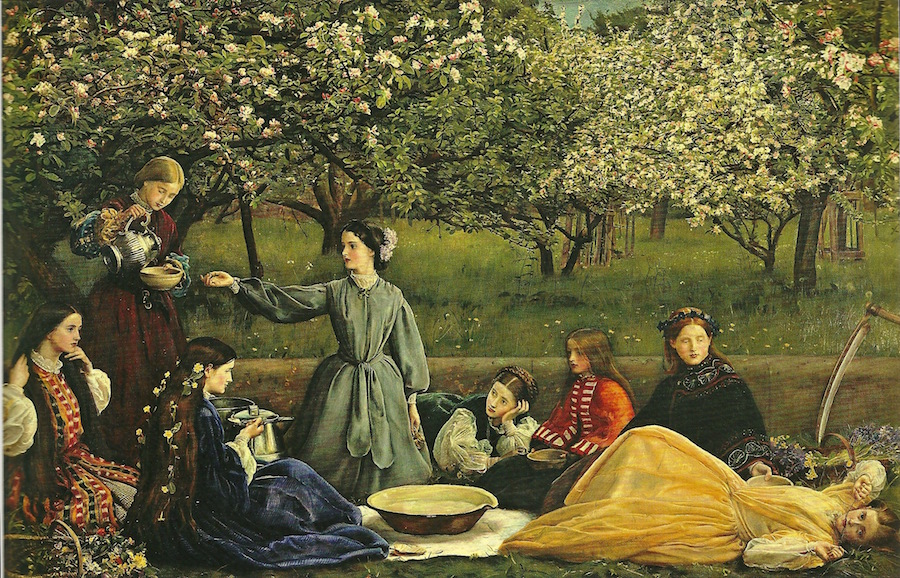
IN THIS ISSUE
GREENVILLE, SOUTH CAROLINA TAKES WING
By John Mariani
NEW YORK CORNER
FLAMES BAR AND GRILL
By John Mariani
NOTES FROM THE WINE CELLAR
DRY CREEK VALLEY SEEKS GREATER RECOGNITION
By John Mariani
❖❖❖
GREENVILLE, SOUTH CAROLINA
TAKES WING
By John Mariani

Falls Park on the Reedy
Greenville
is
proof positive that visionary city fathers, not
least current Mayor Knox White, can change a once
sleepy Southern textile town into a dynamic
attraction for major corporations like BMW,
Michelin and General Electric — good neighbors who
have all poured money into the arts and charity,
leading to a thriving cultural scene.
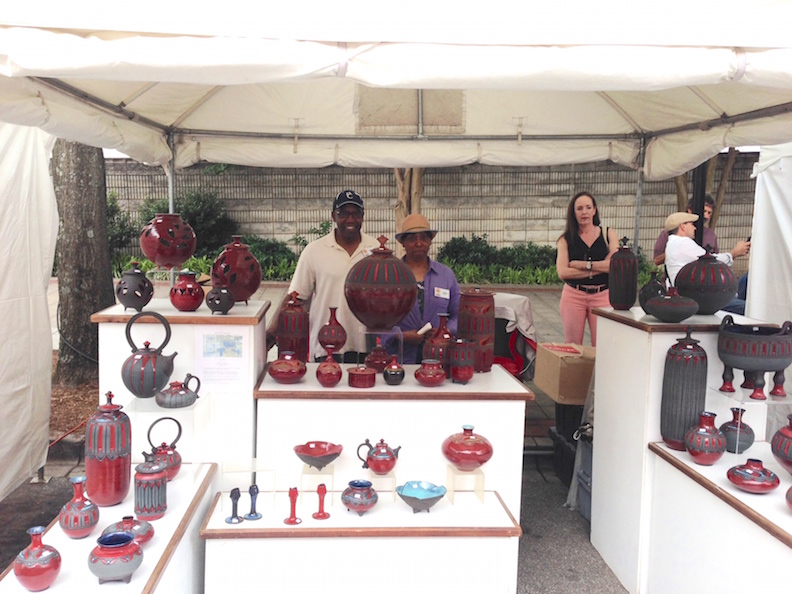 Indeed,
the
annual Artisphere show
that lines “Artists’ Row” in the
Indeed,
the
annual Artisphere show
that lines “Artists’ Row” in the 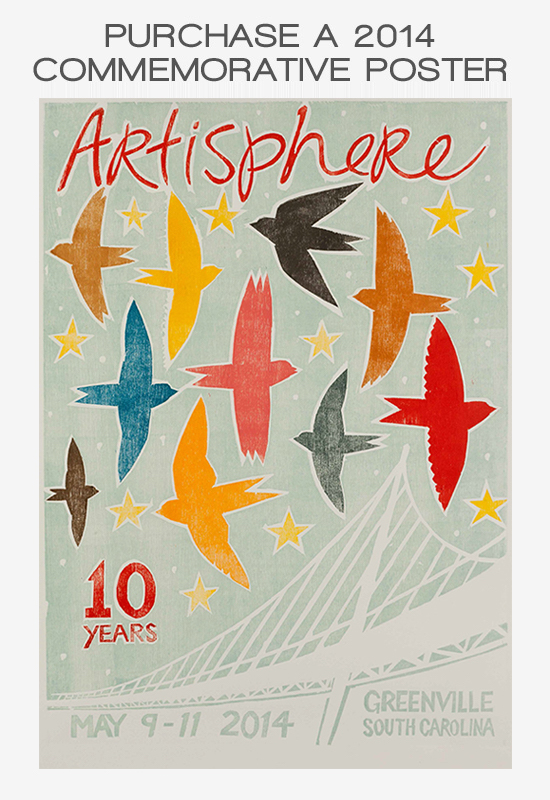 West End and
Gallery Row on Main Street is extremely well
attended, and there is also a Culinary Row with
plenty of good time music throughout. The eleventh
Artisphere will be held this year May 8-10, with
between 100 and 120 artists of all kinds exhibiting
paintings, sculpture, textiles, pottery, ironworks
and ceramics.
West End and
Gallery Row on Main Street is extremely well
attended, and there is also a Culinary Row with
plenty of good time music throughout. The eleventh
Artisphere will be held this year May 8-10, with
between 100 and 120 artists of all kinds exhibiting
paintings, sculpture, textiles, pottery, ironworks
and ceramics.
Larry and
Linda Allen of LA Pottery
Of course there's music, including a fine bluegrass
band, street musicians and entertainers, and all those people need to
eat and to eat well, not just drop into chain
restaurants of a kind that smothers so many Southern
cities where the opening of a California Pizza
Kitchen is cause to celebrate.
Over the past five years
Greenville’s dining scene has approached that mass
level—with more than 100 restaurants and bars open
along Main Street alone—where it bears comparison to
Charleston, Louisville and Nashville for both
variety and local chefs with singular talents. The city
even has its own Dark
Corner Distillery right on Main Street that
makes Appalachian moonshine with names like Hot Mama
and Cock Lightning.
In a similar
vein, American Grocery
Restaurant (732 South Main
Street;
864-232-7665) has garnered national attention
from  Saveur and
the Boston
Globe for Chef-Owner Joe Clarke’s modern take
on the kind of food his grandmother once made for
him while growing up in Spartanburg, SC. Clarke
considers himself largely a self-trained chef; his
early education came from his grandmother’s farm,
where the flavors and techniques of Southern cooking
became indelible by the time he opened American
Grocery with his wife Darlene Mann-Clarke in 2007. That
means
grilled fresh red royal shrimp ($30) with delicious
gnocchi alla
romana and some heightened flavors of chorizo,
fava beans, asparagus and grilled escarole, as well
as a dish that has proven surprisingly popular--
braised beef tongue ($28) with charred onion
spaetzle and a smoked tomato cream (below).
Saveur and
the Boston
Globe for Chef-Owner Joe Clarke’s modern take
on the kind of food his grandmother once made for
him while growing up in Spartanburg, SC. Clarke
considers himself largely a self-trained chef; his
early education came from his grandmother’s farm,
where the flavors and techniques of Southern cooking
became indelible by the time he opened American
Grocery with his wife Darlene Mann-Clarke in 2007. That
means
grilled fresh red royal shrimp ($30) with delicious
gnocchi alla
romana and some heightened flavors of chorizo,
fava beans, asparagus and grilled escarole, as well
as a dish that has proven surprisingly popular--
braised beef tongue ($28) with charred onion
spaetzle and a smoked tomato cream (below).
For a starter
consider the crispy duck egg with red grits, peas
and braised kale at $11, but my favorite was an
appetizer of crispy sweetbreads with socca
crêpes, mushroom-bacon ragoût, and frisée lettuce
($13). There are artisanal cheeses and charcuterie,
as well, including some unusual offerings like
Fiscalini “bandage wrapped cheddar” with bourbon
cherries, and a Goat Lady Dairy Smokey 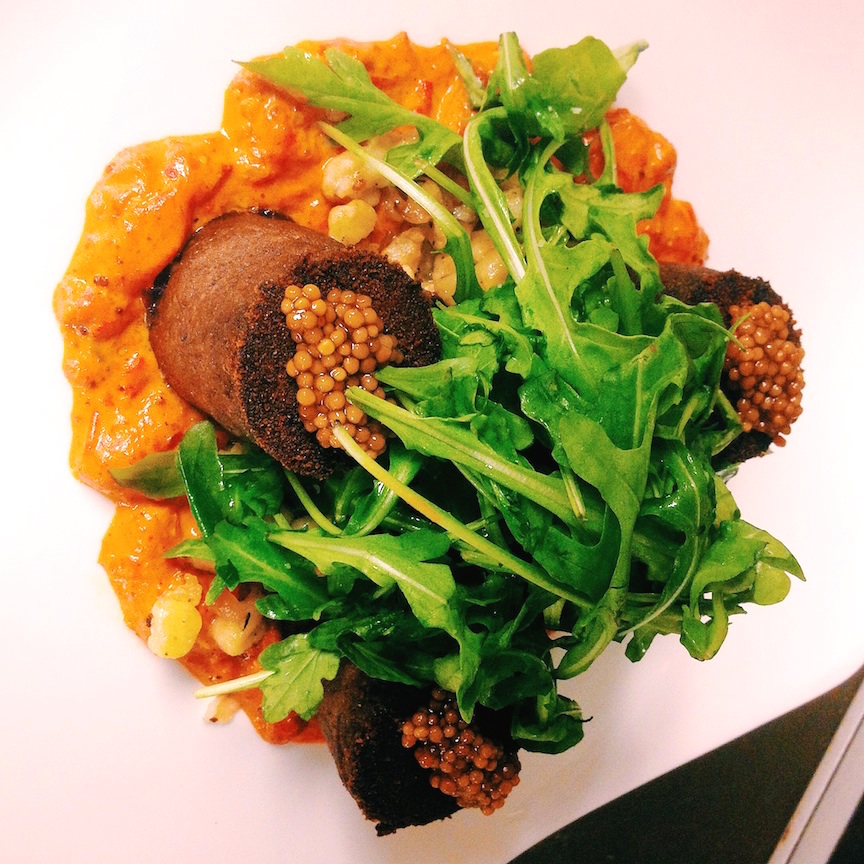 Mountain Round with maldon
sea salt and arbequina olive oil—new to me.
Mountain Round with maldon
sea salt and arbequina olive oil—new to me.
Meanwhile, Darlene stocks one of
the city’s better wine lists of small estates, all
naturally compatible with her husband's lusty
cooking. She is a certified sommelier
through the Court of Master Sommeliers and has
completed both course levels through the
International Sommelier Guild.
American Grocery is a
good-looking, homey place, with brick walls, wooden
columns, near Cubist food art, Johnny Cash on the
playlist, and the room doesn’t get too loud for
civil conversation. There is an artfulness to the
food presentations, however, revealing the
prettiness in some downhome dishes while showing the
savory grit in other more inventive ones.
American Grocery is open Tues.-Sat. for dinner.
One
of
the most charming spots and meeting places in
Greenville is the wonderfully cantilevered Liberty
Bridge beneath which flows white water tumbling over
exposed rocks.
Believe it or not, much of this splendor was
once covered over, but now the river runs under Main
Street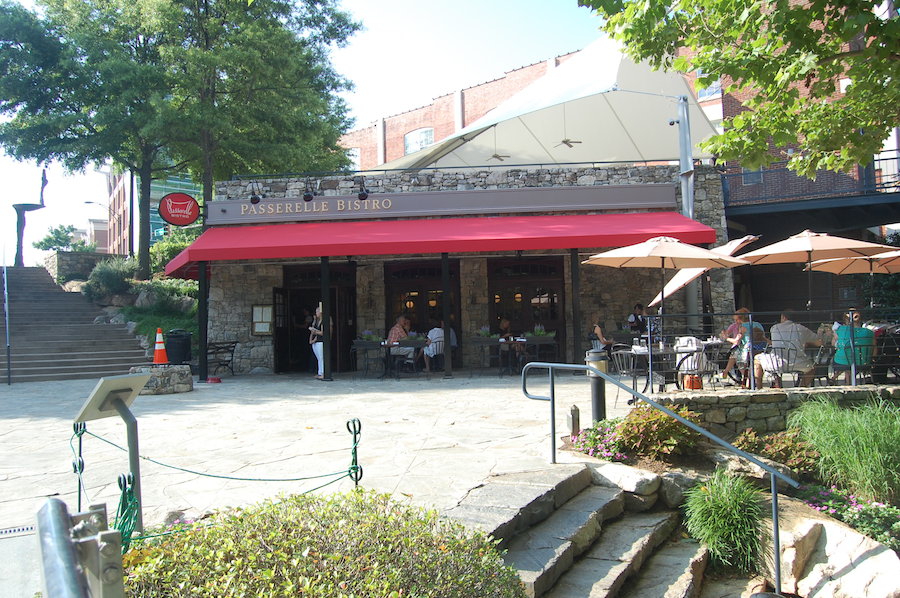 and beyond,
bound by condos, stores and more restaurants. This
was once the site for Greenville’s first European settler,
Richard Pearis, back in 1768, who built a grist mill
here.
and beyond,
bound by condos, stores and more restaurants. This
was once the site for Greenville’s first European settler,
Richard Pearis, back in 1768, who built a grist mill
here.
Just off the bridge and Falls Park is Passarelle Bistro
(601 South Main Street
; 864-509-0142)--passerelle is
French for “footbridge”--a casual new spot where
Chef Teryi Youngblood, now cooking in town for more
than 17 years, has adapted beloved French classics
to South Carolina taste. So you might begin with a
blue cheese-celery terrine and pâté with apricot
mustard fruits, cornichons and cashews on a crusty
baguette, or splurge on a big bowl of mussels ($13)
scented with saffron or basquaise. One of her hearty
seasonal cassoulets ($23) includes a steaming
amalgam of lamb and spicy andouille sausage, veal osso buco,
white beans and Swiss chard. For dessert, don’t miss
the lemon chèvre
pound cake with blueberry compote, Chantilly cream
and vanilla lemon curd ($8).
Passarelle is one of several
restaurants run by the Table 301 Restaurant Group
that pioneered modern dining in the city two decades
ago with places like Soby’s, Nosedive Gastropub, and
The Lazy Goat, and they do their homework. The
exterior has tables with umbrellas, ideal for brunch
(there’s a children’s menu, too), and inside there’s
an open kitchen, marble topped counter, and tables
with bentwood bistro chairs.
Passarelle Bistro is open Tues.-Sat for lunch and dinner
in winter; daily at other times.
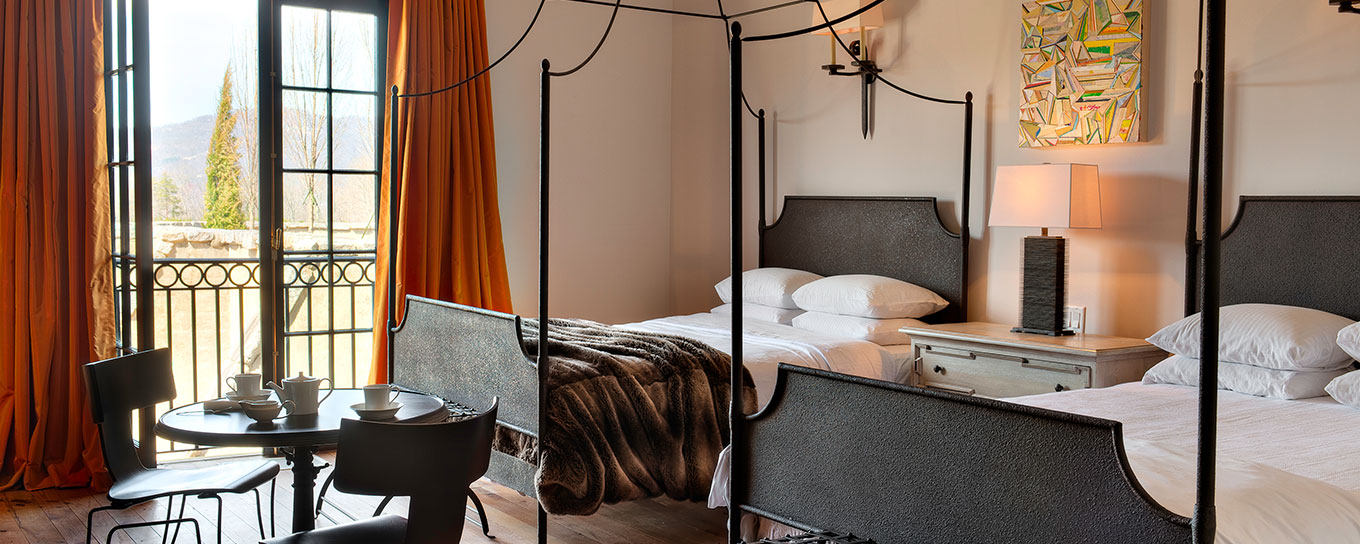 One
of
the most ambitious new dining rooms, Restaurant
17, lies just miles outside of town in
Travelers Rest, within the luxurious resort Hotel
Domestique (864-516-1254), next to one of America’s most
beautiful scenic routes, the Blue Ridge Parkway. It is a
very modern hotel, without faux-19th
century quaintness, so there are metal bedsteads and
abstract art in the bedrooms (left), as well
as fireplaces, and every room has a grand view of
the surrounding grass- and woodlands of the Blue
Ridge Mountains.
One
of
the most ambitious new dining rooms, Restaurant
17, lies just miles outside of town in
Travelers Rest, within the luxurious resort Hotel
Domestique (864-516-1254), next to one of America’s most
beautiful scenic routes, the Blue Ridge Parkway. It is a
very modern hotel, without faux-19th
century quaintness, so there are metal bedsteads and
abstract art in the bedrooms (left), as well
as fireplaces, and every room has a grand view of
the surrounding grass- and woodlands of the Blue
Ridge Mountains.
In a dining room covered in 50
shades of gray, Chef Adam Cooke, from Missoula and a
veteran of Blackberry Farm in Tennessee, here proves
himself a master of international cuisine, ranging
from house-made charcuterie (below) and
artisanal cheeses ($17) 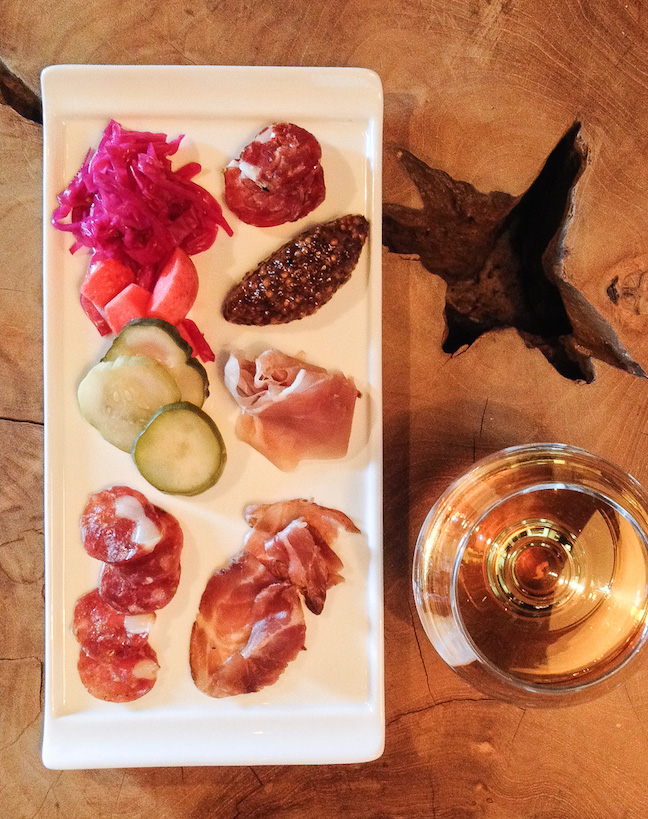 to
a plated wonder of global cuisine that might include
such dishes as Alabama grass-fed hanger steak ($29)
with twice-cooked potato Macaire, rosemary carrots
and luscious black garlic-foie gras bordelaise with
honshimeji mushrooms
(the menu changes almost daily). A pasta
dish of house-made orechiette ($26) with smoked lamb
merguez sausage
and a tomato ragoȗt with preserved lemon, ricotta
and grilled courgettes
was as good as any I’ve had in the South, and crisp
pork belly with eggplant agnolotti,
artichoke, pine nuts, currants, mizuna, and
black olive dust ($14) as an appetizer was
overwrought by about three ingredients too many. Rounds of
rabbit saddle with baby carrots, ramps, wild
mushrooms, and a caraway-scented puree ($26) was
much better balanced.
to
a plated wonder of global cuisine that might include
such dishes as Alabama grass-fed hanger steak ($29)
with twice-cooked potato Macaire, rosemary carrots
and luscious black garlic-foie gras bordelaise with
honshimeji mushrooms
(the menu changes almost daily). A pasta
dish of house-made orechiette ($26) with smoked lamb
merguez sausage
and a tomato ragoȗt with preserved lemon, ricotta
and grilled courgettes
was as good as any I’ve had in the South, and crisp
pork belly with eggplant agnolotti,
artichoke, pine nuts, currants, mizuna, and
black olive dust ($14) as an appetizer was
overwrought by about three ingredients too many. Rounds of
rabbit saddle with baby carrots, ramps, wild
mushrooms, and a caraway-scented puree ($26) was
much better balanced.
Desserts were all excellent, from
a dark chocolate, praline and espresso napoleon ($9)
with Meyer lemon custard and vanilla wafer to a
luscious chocolate buttermilk doughnut with the
surprise of sesame, candied kumquats and brown
butter ($9).
The wine list is already quite
impressive and growing steadily. Cocktails are all
$10, which comes as a relief.
Dinner is served
Tues.-Sat. Café is open for breakfast and lunch
daily.
The hot spot
downtown right now is SIP Tasting Room
& Rooftop Lounge (103 N. Main Street;
864-552-1916),
which overlooks Main Street. Inside it’s
a barebones, low-lighted place with communal high
tables, and outside there are rattan couches and
hassocks on the terrace, with a flow of very
handsome people coming and going throughout the
evening, before and after dinner. People tend to
dress well. People tend to meet new people.
Main Street. Inside it’s
a barebones, low-lighted place with communal high
tables, and outside there are rattan couches and
hassocks on the terrace, with a flow of very
handsome people coming and going throughout the
evening, before and after dinner. People tend to
dress well. People tend to meet new people.
Greenville seems cheese-and-charcuterie crazy
these days, and SIP offers a wide array of both,
along with “Nibbles” of hummus, crudités, breads and
spreads. There are more than two dozen beers, and
the first-rate, always changing wine list has 27
wines by the glass, with most in the $8-$12 range.
Among the bottles, too, there are plenty of
bargains, with dozens of bottlings under $50.
❖❖❖
by John Mariani
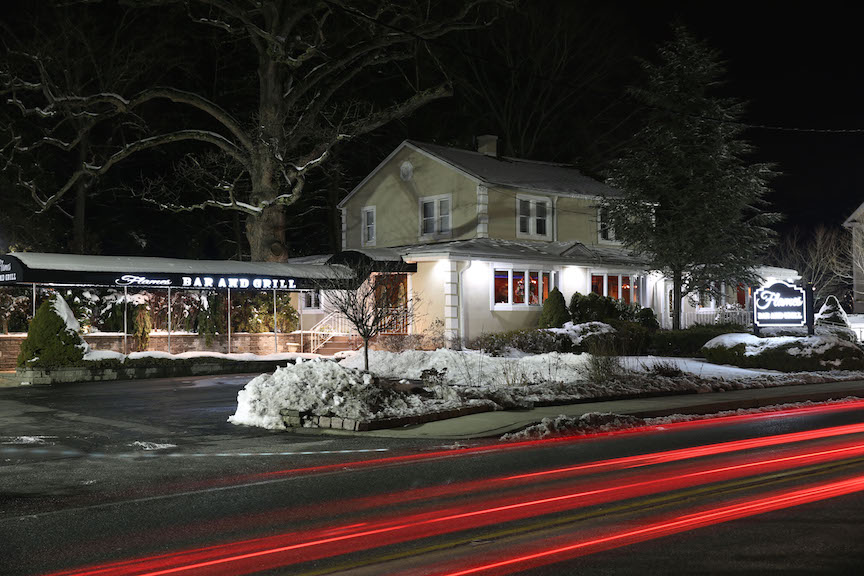 FLAMES BAR
FLAMES BAR AND GRILL
533 North State Road
Briarcliff, NY
914-923-3100
http://flamesbarandgrill.com
I have been happily dining at and writing about
Flames since Nick Vuli opened it in 1992 as a
paragon of a steakhouse whose quality of beef and
other food exceeds that of far better known, much
pricier competitors in New York City. In all
that time Flames has had some added decorous
touches--along with adding “Bar and Grill” to its
name--but now, wholly revamped, it has emerged as
one of the loveliest restaurants in Westchester
County and one of the best looking steakhouses
anywhere.
Now everything about the dining
room and a wholly reconfigured bar-lounge, where a
lot of people eat after hopping off Metro North, is
bathed in a glow of golden and lavender light that
softens every surface of fine, polished woodwork,
soft leather chairs, and plaid curtains that fit
right into this affluent suburban neighborhood, 45
minutes from Manhattan by train or car.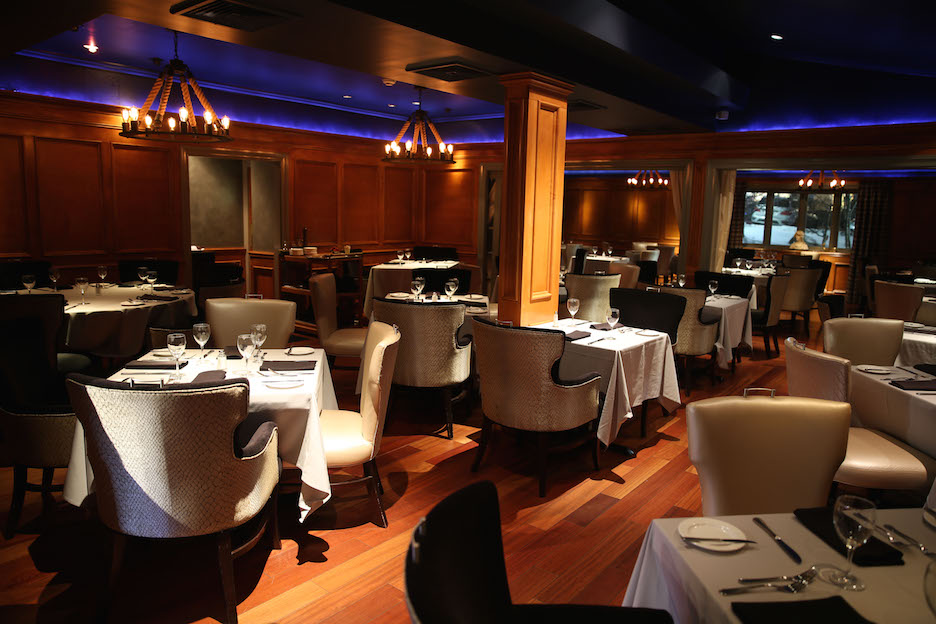
Mr. Vuli has trained
his staff to be alert to guests’ needs within a
moment’s notice, and their own generosity of care is
mirrored in the generosity of the portions at
Flames.
The wine list, cellared in a gorgeous private
dining room downstairs, seems in flux, with far
fewer whites now available than there used to be,
while the stock of reds is still superlative and
very reasonably priced.
Most
important, as the quality of beef continues to slide
at new steakhouses around the country that profess
to serve USDA Prime, there has never been the
slightest decline in the excellence of what Mr. Vuli
buys after so many years in the business. Back in
1992 he made a commitment to buying the finest,
because he knew that it would be a competitive draw
outside of NYC, and he’s held to that commitment
even as the Real McCoy becomes more and more
difficult to find.
But, even before you get to the
steaks and chops, there are decisions to be made
from a large appetizer and pasta menu, which
includes jumbo shrimp ($15.95) and colossal lump
crabmeat ($15.95) that easily live up to their
designations. Eggplant rollatini
($9.50) with prosciutto and fontina in a creamy
tomato sauce is delicious, as is the ahi tuna
($1.95), quickly seared and given a lick of wasabi
and a bed of seaweed.
Fried calamari ($10.95) are cut thickly and
cooked till tender and golden brown, easily shared
by a table of four.
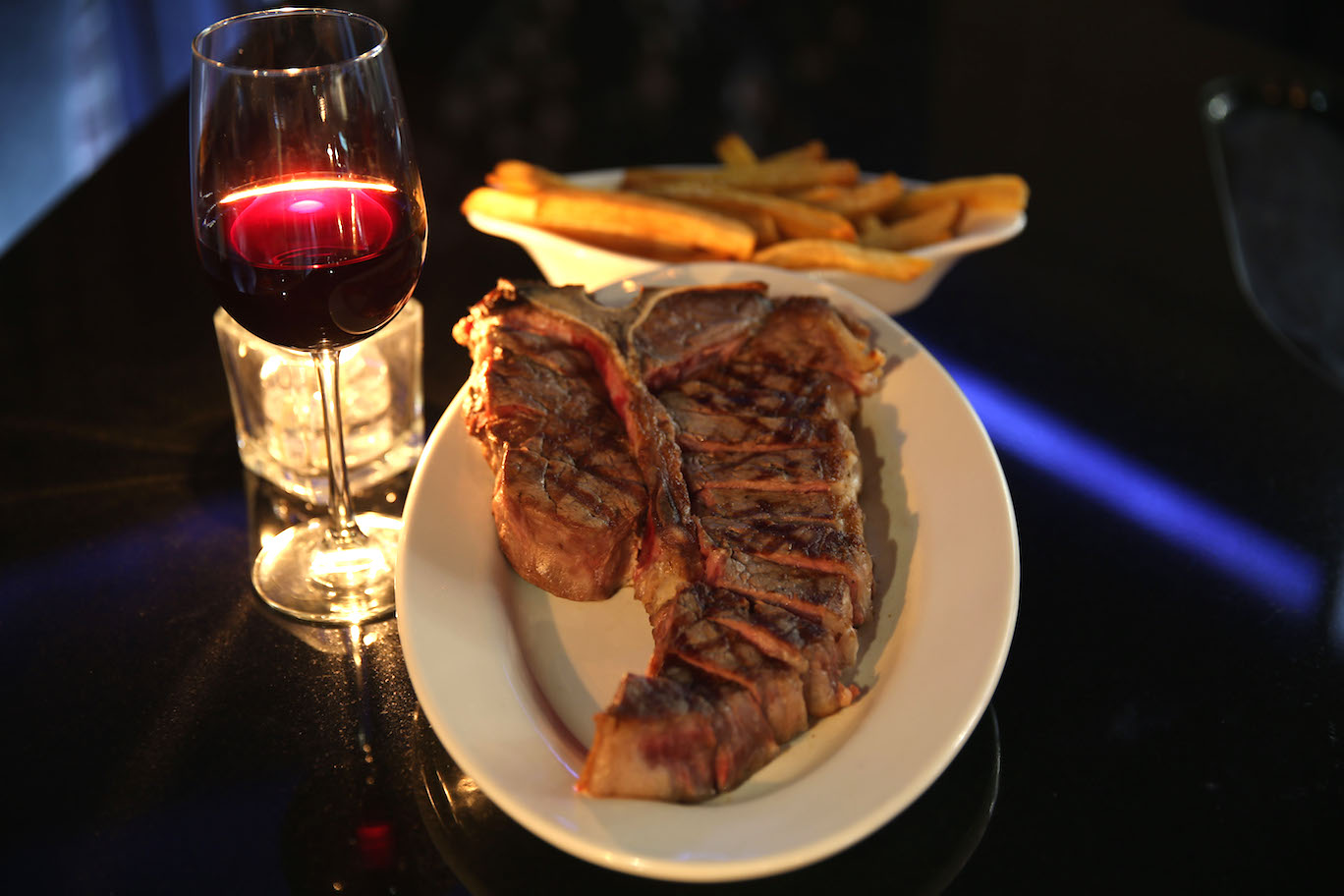 I haven’t
tried any of Flames’s pastas in a while, though I do
recall with pleasure the spaghetti alla carbonara
($21.95) “done the right way,” as the menu says.
I haven’t
tried any of Flames’s pastas in a while, though I do
recall with pleasure the spaghetti alla carbonara
($21.95) “done the right way,” as the menu says.
There are steamed or broiled
lobsters of varying sizes (market price)--three
pounders will feed two--and they are always full of
meat in body and claw. You’ll probably take home part
of your extra thick veal chops ($43.95). The huge
lamb chops ($43.95) are, of course, domestic and
delectable, as is the bone-in shell steak ($43). I was
persuaded that my least favorite cut, filet mignon,
should be tried on the bone, and, aside from the
unexpected rich flavor of the meat itself, the bone
did indeed keep the succulence in a cut so often
dried out. Then
there are mammoth porterhouses (left) for
two ($89.95), three ($127) and four ($170), which
are impeccably seared and cooked at 800 degrees
precisely the way you order them, then sliced and
placed on a very hot serving platter. These
prices are less than you'd pay for in NYC by about
ten bucks.
For side
dishes, you should order the home fries (not crispy
enough on my last visit) and the creamed spinach.
Desserts are up to you: they’re
competently made, including a good cheesecake and
the textbook crème brûlée.
After nearly a quarter century in
business, Flames is regarded in Westchester and the
surrounding counties as a classic restaurant of
consistent quality.
For commuters, it’s far easier to dine well
here than to navigate their way to Palm or Spark’s
or Peter Luger’s, and for those whose appetite for
finding the best steakhouses in the region will draw
them out of NYC, Briarcliff is less than hour a way.
Flames is open Tues.-Sun. from 11 A.M. to 10 P.M.
❖❖❖
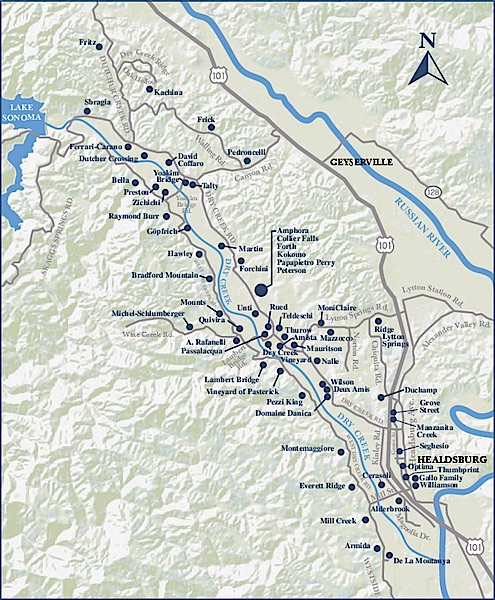
DRY CREEK VALLEY SEEKS GREATER RECOGNITION
By John Mariani
Terroirs and micro-climates can be confusing for
even the dedicated wine drinker who has difficulty
enough learning the distinctions between Pomerol
and Médoc in Bordeaux, Bolgheri and Montalcino in
Tuscany, and Stags Leap and Howell Mountain in
Napa. So it is understandable that any mention of
Dry Creek Valley in Sonoma may bring to mind the
winery named Dry Creek Vineyard in Healdsburg,
rather than the entire area by that same name. Dry
Creek Valley is home to 70 wineries, spread
over 2,400 acres, a mid-sized appellation (third
largest in Sonoma) whose viticultural history goes
back to the California Gold Rush era, when
zinfandel became the predominant grape variety
planted; today its plantings are surpassed only by
cabernet sauvignon.
The temperatures in the valley
almost never reach the extreme high heat more
usual in Napa Valley; nights are cooled by oceanic
fog, and frosts are rare. Grapes seem to love
living there.
E&J Gallo is a major owner
of land in Sonoma, with holdings in Dry Creek,
using its grapes to make some of its Signature
Series wines and the Frei Brothers label, while
other estates, like A. Rafanelli, Frick, Sbragia,
Ridge Lytton Springs and others compare with the
best from Napa. But therein lies an image problem.
Ever since the 1970s, led by
vintners like Robert Mondavi, Napa Valley has
captured the spotlight as America’s wine capital,
based as much on full-bodied, well-oaked
chardonnays and cabernet sauvignons as on the
Silicon Valley billionaires who bought up
hyper-expensive vineyards as trophy wineries. With
more money to spend promoting Napa Valley, as both
a wine and resort destination, the more its
profile among wine drinkers and media has grown. Dry
Creek Valley, and by extension Sonoma, has in turn
been treated more like a California step-sister,
who is undoubtedly pretty and talented but lacks
the glamour of Napa appellations like Calistoga,
Atlas Peak, and Carneros.
Part
of the problem is Dry Creek’s biggest
success--zinfandel, which finds its finest
expression in the terroir as a bold, rich 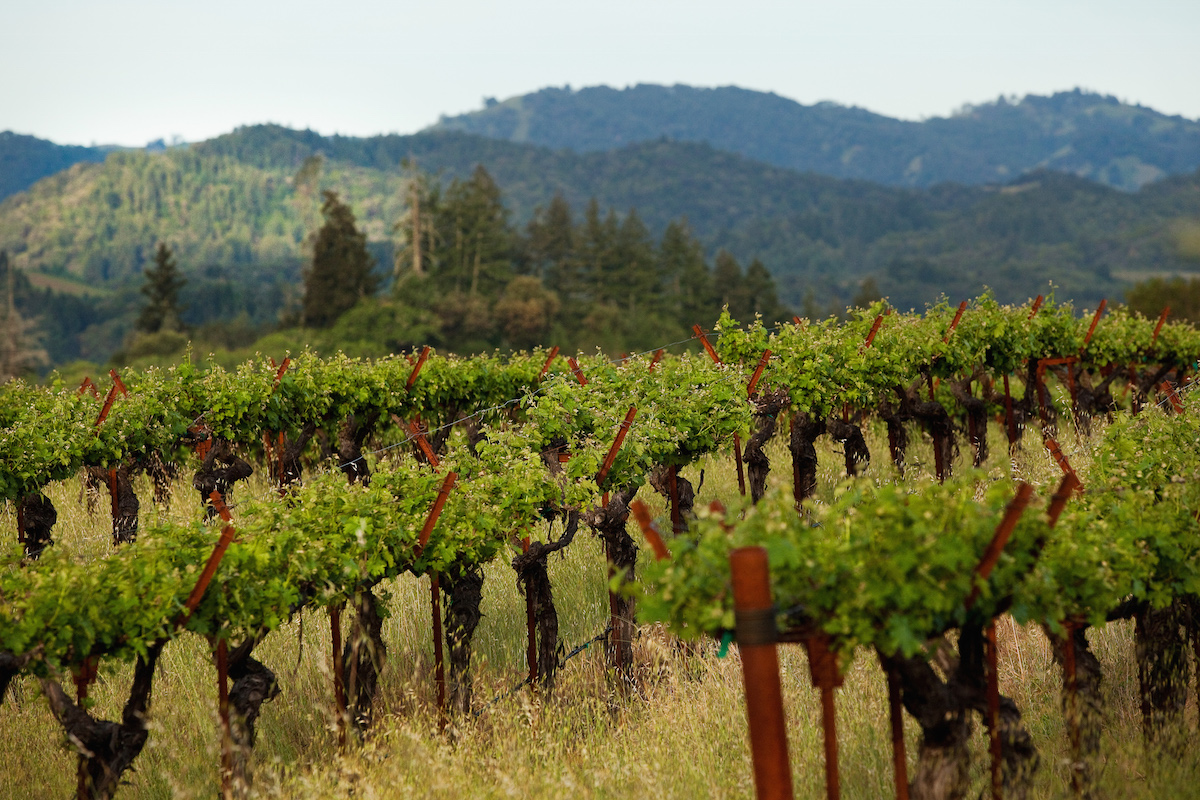 red wine
with plenty of spice and backbone. But,
because there is so much run-of-the-mill
zinfandel, and because of its association with the
enormously successful and cheap but bland,
slightly sweet white zinfandel (actually a rosé
made from red grapes), the region suffers.
red wine
with plenty of spice and backbone. But,
because there is so much run-of-the-mill
zinfandel, and because of its association with the
enormously successful and cheap but bland,
slightly sweet white zinfandel (actually a rosé
made from red grapes), the region suffers.
Another ironic success that
hinders Dry Creek Valley’s visibility in the
market is that a large number of the region’s
estates--95 percent of which are small
wineries--sell their wines primarily through mail
order. “Selling
to a consistent clientele on a regular basis is
not just cost-effective but allows wineries to be
true to their own style,” says Ann Petersen, a
marketing expert appointed Executive Director of
the Winegrowers of Dry Creek Valley a year ago. “They
are not ruled by the supermarkets that only want a
certain kind of wine for mass purchase.”
Over dinner at Aureole
restaurant in New York, Ms. Petersen told me: “Dry
Creek Valley’s terroir is actually more varied
than most of Sonoma’s. It’s really the heartland of
Sonoma County. Our aim is to make our name better
known around the world. There’s even a lot of
discussion going on about China, which may emerge
as a major wine market in the future.”
Ms. Petersen also pointed out that so many
of Dry Creek Valley’s best wines are so much lower
priced than comparable bottlings from Napa, and
proved it by pouring two superb zinfandels--A.
Rafanelli and Sbragia.
Nevertheless, mass-market
buyers of zinfandel have a problem spending more
than $10 for a bottle, and getting above that
price point is tough for any premium winery in the
entire industry. “We also face fierce competition
from the craft beer industry and wine imports,
which is just soaring in the market. When
you know you can buy a 12-ounce bottle of
artisanal beer for $4.25 or a six-pack of
commercial beer for $12, many of the millennials
people are reluctant to consider a good bottle of
wine for $20 or more.”
I noted that, while America is
drinking more wine every year, those who pay more
than $10 a bottle once a week or less--who are
considered by the wine industry as “regular wine
drinkers”--are still only about 5 percent
of all American wine drinkers. Only a minuscule
number can afford to buy $500 Napa cabernets, or
$1,000 Burgundies--the Teflon-proof elite of the
market. Vintners
in Dry Creek Valley need not concern themselves
with such label-driven buyers. Peterson said the
region's “core, older consumer has no problem
spending more than $20 a bottle, and the premium
segment is
expanding. In Dry Creek we specialize in
small-production, high-quality products that just
don’t fit into the $10 bottle at retail price
point.”
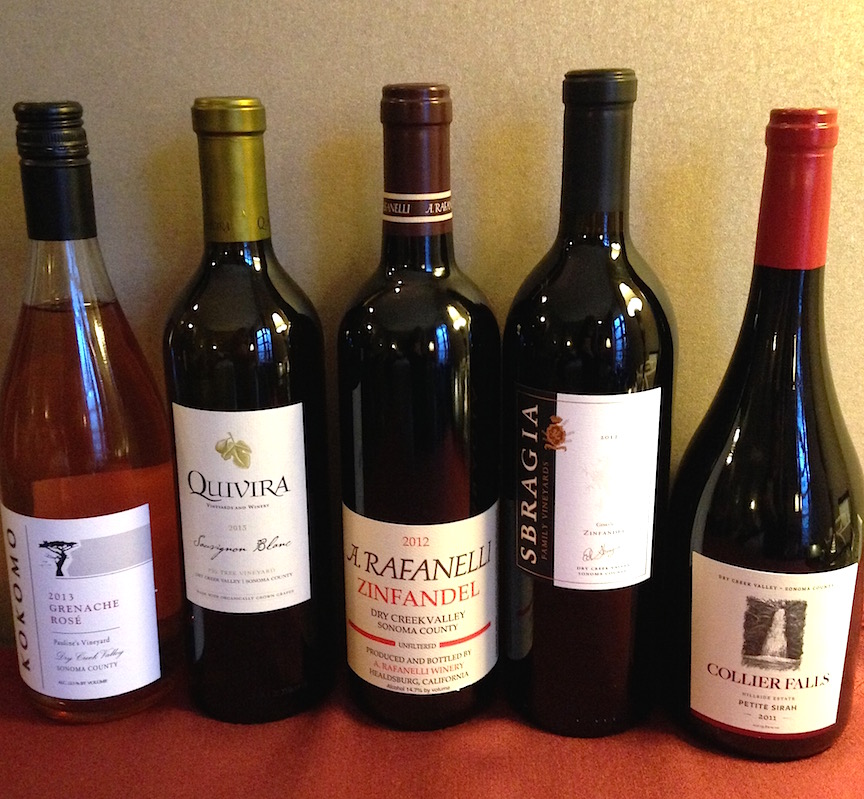 To
prove her point that Dry Creek has an
exceptionally varied terroir, and to show off fine
examples of zinfandel and other varietals, she
brought with her an array of wines most serious
wine drinkers would consider very high quality. Collier
Falls produces a 100% petite sirah ($40)--a
much-neglected varietal not
related to syrah/shiraz—from the 2011 vintage. Only
113 cases were produced and it’s a beauty at just
13.8% alcohol, showing rich plum-like flavors in
tandem with the varietal’s peppery component.
To
prove her point that Dry Creek has an
exceptionally varied terroir, and to show off fine
examples of zinfandel and other varietals, she
brought with her an array of wines most serious
wine drinkers would consider very high quality. Collier
Falls produces a 100% petite sirah ($40)--a
much-neglected varietal not
related to syrah/shiraz—from the 2011 vintage. Only
113 cases were produced and it’s a beauty at just
13.8% alcohol, showing rich plum-like flavors in
tandem with the varietal’s peppery component.
Just as delightful was a 2013
grenache rosé by an estate named Kokomo (the owner
comes from Kokomo, Indiana), with 12.5% alcohol
that makes it easy to drink and more berry flavor
without the cloying sweetness of so many
California rosés.
With just 502 cases made and a price of
$24, it should be much sought out, once tasted.
Sbragia Family Vineyards has a
deserved reputation for its zinfandel, and it’s
easy to see why upon smelling and tasting its 2012
La Promessa ($48), made from a young vineyard in
the warmest part of the valley. The zinfandel is
given a fruited boost from 5% petite sirah, but
it’s high 15.5% alcohol means it is not destined
for longevity and is best drunk now, with
something very hearty and intensely flavored like
the braised wagyu beef cheek with horseradish we
enjoyed that evening.
An even more appealing and more
complex zinfandel was a bottle of 2012 vintage
from A. Rafanelli ($39). The grapes are all hand
harvested and hand sorted, with fermentation
taking place in small open top tanks, where the
cap is punched down manually; the new
wines are then put into oak tanks and matured for
18 months in new French oak barrels, racked four
to six times, and never fined or filtered.
Nevertheless, the alcohol level
is a reasonable 14.7% for a zinfandel with 7%
petite sirah.
Ideal weather through the year gave the
wine impeccable balance, and big ripe flavors. Despite
the winery claiming the bottling has “jammy
blackberry fruit, thick and juicy,” I found it
more luscious than tasting like fruit preserves.
It was California zinfandel--not a native
grape--at its best, a kind of Dry Creek diadem
whose fineness is in good company with other
varietals that deserve to be better known.
Still, Rafanelli, like the
majority of Dry Creek estates, sells its wines
only at the winery, or through restaurants, which
is terrific for Rafanelli and its visitors but not
for the rest of us who need better access to such
great California wines.
Passport to Dry Creek Valley®
is a weekend event when the winegrowing community
comes together to celebrate the generations of
farmers, vintners and families of the Dry Creek
Valley wine region. Over April 25-26, Passport
guests are welcomed into 45+ wineries throughout
Dry Creek Valley, each offering a unique pairing
of premium wine, gourmet food and entertainment.
Tickets are limited and are available on a
first-come-first-served basis February 1st at 10
am pst. Click here for complete list of part http://www.drycreekvalley.org/events/passport-to-dry-creek-valley.php
THE LAS VEGAS STRIP, OF COURSE,
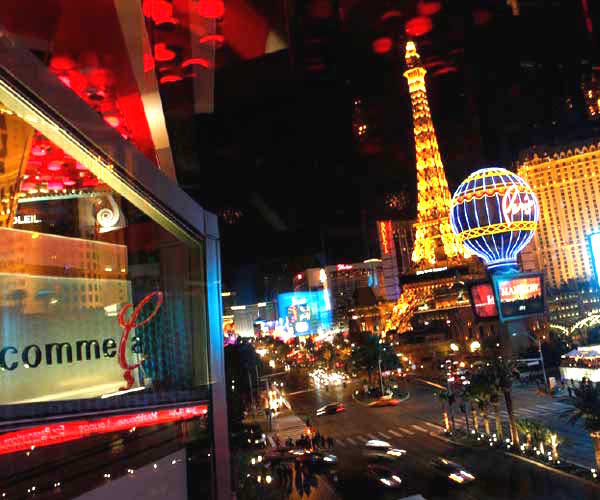
BEING FAR FROM METRO MADNESS
"Be prepared
for date night with advance reservations and built-in
views at these restaurants above some of America's most
iconic cities and landmarks. If romance means getting
out of metropolitan madness for you, book a rendezvous
over the bright lights of the Vegas Strip at Comme Ça."—Ashley
Day, “Love is in
the air at restaurants with aerial views,” USA Today (2/1/15)
IN A MILLION, ZILLION YEARS THINK OF DOING!
1. Buy an instant-read digital meat thermometer.
2. Write in your cookbooks
3. Replace your non-stick skillet.

4. Double that batch of rice.
5. Buy parchment paper
6. Buy a new kitchen sponge
7. Use a garbage bowl
8. Stop crowding your pans
9. Salt your salads
10. Buy a better ice tray
❖❖❖
Any of John Mariani's books below may be ordered from amazon.com.
 I'm proud and happy to announce that my
new book, The Hound
in Heaven (21st Century Lion Books), has just
been published through Amazon and Kindle.
I'm proud and happy to announce that my
new book, The Hound
in Heaven (21st Century Lion Books), has just
been published through Amazon and Kindle. It is a novella, and for anyone who loves dogs, Christmas, romance, inspiration, even the supernatural, I hope you'll find this to be a treasured favorite. The story concerns how, after a New England teacher, his wife and their two daughters adopt a stray puppy found in their barn in northern Maine, their lives seem full of promise. But when tragedy strikes, their wonderful dog Lazarus and the spirit of Christmas are the only things that may bring back his master back from the edge of despair.
WATCH THE VIDEO!
“What a huge surprise turn this story took! I was completely stunned! I truly enjoyed this book and its message.” – Actress Ali MacGraw
“He had me at Page One. The amount of heart, human insight, soul searching, and deft literary strength that John Mariani pours into this airtight novella is vertigo-inducing. Perhaps ‘wow’ would be the best comment.” – James Dalessandro, author of Bohemian Heart and 1906.
“John Mariani’s Hound in Heaven starts with a well-painted portrayal of an American family, along with the requisite dog. A surprise event flips the action of the novel and captures us for a voyage leading to a hopeful and heart-warming message. A page turning, one sitting read, it’s the perfect antidote for the winter and promotion of holiday celebration.” – Ann Pearlman, author of The Christmas Cookie Club and A Gift for my Sister.
“John Mariani’s concise, achingly beautiful novella pulls a literary rabbit out of a hat – a mash-up of the cosmic and the intimate, the tragic and the heart-warming – a Christmas tale for all ages, and all faiths. Read it to your children, read it to yourself… but read it. Early and often. Highly recommended.” – Jay Bonansinga, New York Times bestselling author of Pinkerton’s War, The Sinking of The Eastland, and The Walking Dead: The Road To Woodbury.
“Amazing things happen when you open your heart to an animal. The Hound in Heaven delivers a powerful story of healing that is forged in the spiritual relationship between a man and his best friend. The book brings a message of hope that can enrich our images of family, love, and loss.” – Dr. Barbara Royal, author of The Royal Treatment.
 |
The Encyclopedia of American Food and Drink by John F. Mariani (Bloomsbury USA, $35) Modesty forbids me to praise my own new book, but let me proudly say that it is an extensive revision of the 4th edition that appeared more than a decade ago, before locavores, molecular cuisine, modernist cuisine, the Food Network and so much more, now included. Word origins have been completely updated, as have per capita consumption and production stats. Most important, for the first time since publication in the 1980s, the book includes more than 100 biographies of Americans who have changed the way we cook, eat and drink -- from Fannie Farmer and Julia Child to Robert Mondavi and Thomas Keller. "This book is amazing! It has entries for everything from `abalone' to `zwieback,' plus more than 500 recipes for classic American dishes and drinks."--Devra First, The Boston Globe. "Much needed in any kitchen library."--Bon Appetit. |
"Eating Italian will never be the same after reading John Mariani's entertaining and savory gastronomical history of the cuisine of Italy and how it won over appetites worldwide. . . . This book is such a tasteful narrative that it will literally make you hungry for Italian food and arouse your appetite for gastronomical history."--Don Oldenburg, USA Today. "Italian
restaurants--some good, some glitzy--far
outnumber their French rivals. Many of
these establishments are zestfully described
in How Italian Food Conquered the World, an
entertaining and fact-filled chronicle by
food-and-wine correspondent John F.
Mariani."--Aram Bakshian Jr., Wall Street
Journal.
"Equal parts
history, sociology, gastronomy, and just
plain fun, How Italian Food Conquered the
World tells the captivating and delicious
story of the (let's face it) everybody's
favorite cuisine with clarity, verve and
more than one surprise."--Colman Andrews,
editorial director of The Daily
Meal.com. "A fantastic and fascinating
read, covering everything from the influence
of Venice's spice trade to the impact of
Italian immigrants in America and the
evolution of alta cucina. This book will
serve as a terrific resource to anyone
interested in the real story of Italian
food."--Mary Ann Esposito, host of PBS-TV's
Ciao
Italia. "John Mariani has written the
definitive history of how Italians won their
way into our hearts, minds, and
stomachs. It's a story of pleasure over
pomp and taste over technique."--Danny Meyer,
owner of NYC restaurants Union Square
Cafe, The Modern, and Maialino.
|
 |
 |
 |
 |
 |
 |
 |
 |
 Everett Potter's Travel Report:
Everett Potter's Travel Report: 
 Eating Las Vegas
is the new on-line site for Virtual Gourmet
contributor John A. Curtas., who since 1995
has been commenting on the Las Vegas food
scene and reviewing restaurants for Nevada
Public Radio. He is also the
restaurant critic for KLAS TV, Channel 8 in
Las Vegas, and his past reviews can be
accessed at KNPR.org.
Click on the logo below to go directly to
his site.
Eating Las Vegas
is the new on-line site for Virtual Gourmet
contributor John A. Curtas., who since 1995
has been commenting on the Las Vegas food
scene and reviewing restaurants for Nevada
Public Radio. He is also the
restaurant critic for KLAS TV, Channel 8 in
Las Vegas, and his past reviews can be
accessed at KNPR.org.
Click on the logo below to go directly to
his site.

Tennis Resorts Online: A Critical Guide to the World's Best Tennis Resorts and Tennis Camps, published by ROGER COX, who has spent more than two decades writing about tennis travel, including a 17-year stretch for Tennis magazine. He has also written for Arthur Frommer's Budget Travel, New York Magazine, Travel & Leisure, Esquire, Money, USTA Magazine, Men's Journal, and The Robb Report. He has authored two books-The World's Best Tennis Vacations (Stephen Greene Press/Viking Penguin, 1990) and The Best Places to Stay in the Rockies (Houghton Mifflin, 1992 & 1994), and the Melbourne (Australia) chapter to the Wall Street Journal Business Guide to Cities of the Pacific Rim (Fodor's Travel Guides, 1991).


MARIANI'S VIRTUAL GOURMET
NEWSLETTER is published weekly. Editor/Publisher: John
Mariani.
Editor: Walter Bagley. Contributing Writers: Christopher Mariani,
Robert Mariani, Misha
Mariani,
John A. Curtas, Edward Brivio, Mort Hochstein,
Andrew Chalk, Dotty Griffith and Brian Freedman. Contributing
Photographers: Galina Dargery, Bobby
Pirillo. Technical Advisor: Gerry McLoughlin.
To un-subscribe from this newsletter,click here.
© copyright John Mariani 2015
